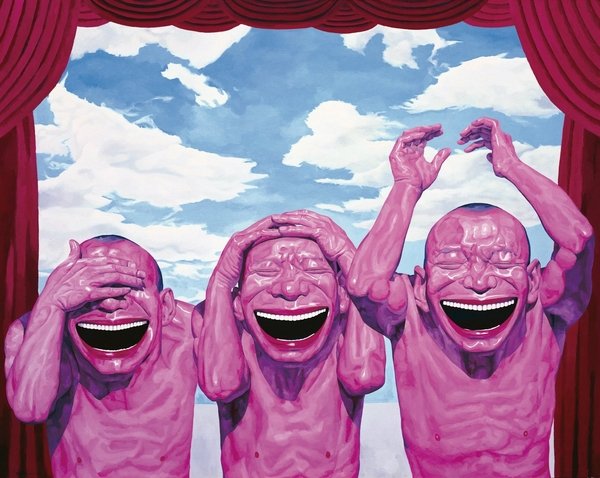Chinamania
dal 26/6/2009 al 26/9/2009
Segnalato da
Fang Lijun
Yue Minjun
Yang Shaobin
Wang Guangyi
Zhang Xiaogang
Zhou Chunya
Mao Yan
Qi Zhilong
Liu Ye
Li Jikai
Wei Jia
26/6/2009
Chinamania
Arken Museum of Modern Art, Ishoj
A selection of Chinese contemporary painting. Figurative painting and photorealism mixes with expressive brushstrokes and sweet comics-aesthetic from artists whose careers soared in the 1990s and to the young artist generation of today. The exhibition highlights how the artists - in each their unique fashion - challenge and add their own takes on the country's classical art forms. They derive inspiration from the rest of the world, a western art tradition and the images of popular culture.

Figurative painting and photorealism mixes with expressive brushstrokes and sweet comics-aesthetic, when ARKEN during the summer of 2009 presents an eminent selection of Chinese contemporary painting.
The exhibition shows a nuanced picture of China’s painting scene today. From artists whose careers soared in the 1990s and to the young artist generation of today. The exhibition highlights how the artists – in each their unique fashion – challenge and add their own takes on the country’s classical art forms.
The artists experiment with new painterly expressions. They derive inspiration from the rest of the world, a western art tradition and the images of popular culture.
Artists: Fang Lijun / Yue Minjun / Yang Shaobin /Wang Guangyi / Zhang Xiaogang / Zhou Chunya / Mao Yan / Qi Zhilong/ Liu Ye / Li Jikai / Wei Jia
Work introductions
See no evil, hear no evil, but speak. In Yue Minjun’s painting
Outside and On the Stage (2009) three hysterically laughing clones
appear before a stage with a red curtain. The sky behind them –
the symbol of the space of freedom – is executed as an illusionist
backdrop. The three laughing clones partly mime the old saying ‘see
no evil, hear no evil, speak no evil’. According to the saying, however,
the last figure usually holds its hands over its mouth. In Yue’s painting
instead the third clone holds his hands up in the air triumphantly.
The work describes a situation in which the individual is able to
speak but not see or hear. Yue employs the figures to take a critical
stance towards the strict censorship and collective homogeneity
distinguishing Chinese culture and history. At the same time, with
the title Outside and On the Stage, he points out the hierarchical
differentiation between Western and non-Western art that governs
the international art scene. Like the three figures in the painting,
China’s contemporary artists are both outside and on the stage.
Women images. In his portrait series Chinese Girls (2008) Qi Zhilong explores the duality characteristic of China’s development from an anti-capitalist
Communist society to Deng Xiaoping’s market oriented socialism of today. In
Qi’s portraits of women our time’s consumer culture is juxtaposed with romantic memories from the days of the revolution when the uniformed youths were
celebrated for their courage and commitment. The three portraits in the exhibition depict young female red guards. At first glance we are seduced by the girls’
innocent appearance, their black almond eyes and long schoolgirl plaits. The girls
look neither raw nor in fighting trim, but rather resemble innocent doe-eyed
schoolgirls. Their gazes go from innocence to terror. By removing characteristic
Communist marks, e.g. the red star, Qi imbues the portraits with a whole other
meaning which goes against the traditional portraiture of the heroes of the
revolution. When Qi decides only to portray young female models with an innocent expression, he is also referring to the consumer culture of today, where
posters of young, beautiful and uniform models permeate the city space and
fashion magazines.
All alone. In Li Jikai’s Mushroom (2009) a small blackhaired boy is sitting in front of a giant and obviously very
poisonous, yellow toadstool with black dots. The earth is
desiccated, and the only natural plant growth left are the
poisonous toadstools. A white hose snakes across the
ground. The hose is a recurrent motif in Li’s works. With
the other recurrent objects – empty boxes, an open book
with blank pages and broken boards – it symbolises rests
of a shattered civilisation where only a single human has
been left. The painting shows a state of gloom, loss and
loneliness which recurs in Li’s paintings.
Li represents a young generation of artists, often known
under the heading ‘the ego generation.’ In an attempt to
gain greater insight into human identity and psychology,
the young artists replace social issues with individual ones.
China’s political past, oriented towards collective communities, has been replaced with themes relating to their own
lives, dreams and feelings.
Image: Yue Minjun Outside and Inside the Stage, 2009
Communications Manager
Christina Bilde tel: +45 40 747222 bilde@arken.dk
ARKEN Museum of Modern Art
DK-2635 Ishøj Skovvej 100
Hours
Wednesday: 10-21
Monday: Closed
Admission
Tuesday-sunday: 10-17
Adults: 85 kr.
Groups (min. 10): 75 kr.
Pensioniers: 70 kr.
Students: 70 kr.
Children under 18: Free



